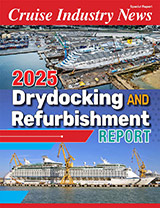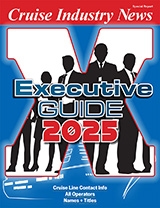Carnival Corporation reported net income of $390 million, or $0.49 per share, on revenues of $3.4 billion for its second quarter ended May 31, 2008, compared to net income of $390 million, or $0.48 per share, on revenues of $2.9 billion for the same quarter last year.
Carnival Chairman and CEO Micky Arison said in a prepared statement that the second quarter results were better than the guidance provided in March due to stronger than expected revenue yields and lower than expected cruise costs.
The results were driven by higher than expected cruise ticket revenue in North America, which were partially offset by lower than expected onboard spending; lower than expected selling and administrative costs; and lower than expected fuel consumption, according to David Bernstein, executive vice president and CFO, on the company’s Q2 earnings call.
The biggest drop in onboard spending was in the art auctions, according to Bernstein, who said that other areas were affected as well.
Passenger capacity was up 8.3 percent from last year, with the North American brands up 2.2 percent and the European brands up 23 percent. Ticket yields for the North American brands were up 7.6 percent and 6 percent for the European brands ,excluding Iberocruceros.
Bernstein commented that Down Under, P&O Australia is also seeing healthy yield improvement and that Costa Crociere has improved both pricing and occupancy in China.
Fuel prices were up 59 percent over the second quarter last year, according to Bernstein, who said that equates to 19 cents per share. The forecast for the rest of the year is that “controllable” expenses will be down slightly.
Outlook
Vice Chairman and COO Howard Frank said that the booking pace was somewhat slower than last year, but that pricing is holding up quite well. “We expect (ticket) prices to be higher, but offset by lower onboard spending,” Frank said. Carnival is seeing particular strength in the seven-day and shorter Caribbean markets, where pricing continues to be strong.
Frank also pointed out that in light of a 21 percent capacity increase over last year, the European brands are performing extremely well, and that combined, the North American and European brands will generate a revenue yield increase in the I percent to 2 percent range over last year. Fuel costs for the year are estimated to be 92 cents per share more than in 2007. Carnival’s earnings guidance for the year is from $2.70 to $2.90 per share, down 35 cents from its previous guidance – 27 cents from higher fuel costs, 4 cents by lower onboard spending and 4 cents from increased operating costs.
Q3 and 4
For Q3, passenger capacity will be up 8.8 percent – 2 percent in North America and 24 percent in Europe. Occupancy is running slightly behind, Frank said, with pricing slightly ahead.\ Carnival’s earnings forecast for Q3 is from $1.56 to $1.58, compared to actual earnings of $1.57 a year ago.
Capacity will also be up 8.8 percent for Q4, with fleet-wide occupancy “even and pricing nicely higher,” Frank said. The North American brands will have 42 percent of their capacity in the Caribbean, compared to 46 percent last year; 12 percent on the Mexican Riviera, which is more or less the same as last year; and 12 percent in Europe, compared to 10 percent last year. The European brands will have 77 percent of their capacity in Europe, compared to 81 percent a year ago.
2009
For QI, 2009, the fleet-wide capacity will be up 2 percent, excluding Iberocruceros. So far, occupancy is running ahead of last year and pricing is flat, Frank said. The North American brands will have 51 percent of their capacity in the Caribbean, the same as last year, and 12 percent on the Mexican Riveria, down from 15 percent last year. The European brands will have 32 percent of their capacity in the Caribbean, compared to 37 percent last year.
Chairman’s Comments
Reflecting on the adjustment of Carnival Cruises lines’ capacity in Europe in 2009, Arison said on the earnings call that it was a small reduction – in the 20 percent range on a small base – and that the market should not read too much into it. As for airlift, Arison said that what is happening in the airline industry is a concern for everybody and that the company will have to work its way through with the airlines.
Arison also said there has been no market resistance to the fuel surcharges. “The public understanding and level of acceptance have been quite high,” he noted.
Meanwhile, one brand is lagging, and that is Iberocruceros, which is “to some extent underperforming to Carnival’s expectations,” according to Arison, who said that the Spanish economy has been hardest hit in Europe with the housing crisis and other issues. “There is a general sense that the European economies are weakening, but we are seeing it most in Spain and to some extent in Italy as well,” Arison said.
Arison also used the opportunity to praise travel agents. He said that after last year’s retirement of longtime Carnival Cruise Lines President and CEO Bob Dickinson, two other senior sales and marketing executives (not mentioning them by name) left for competing companies, and pointed out that the new management team under Gerry Cahill has since changed the brand’s sales strategy, with less emphasis on direct bookings, the result of which has been increased yield (thanks to travel agents, Arison said) and lower sales and administrative costs. Arison said he expects less direct business going forward, especially at the Carnival brand.



